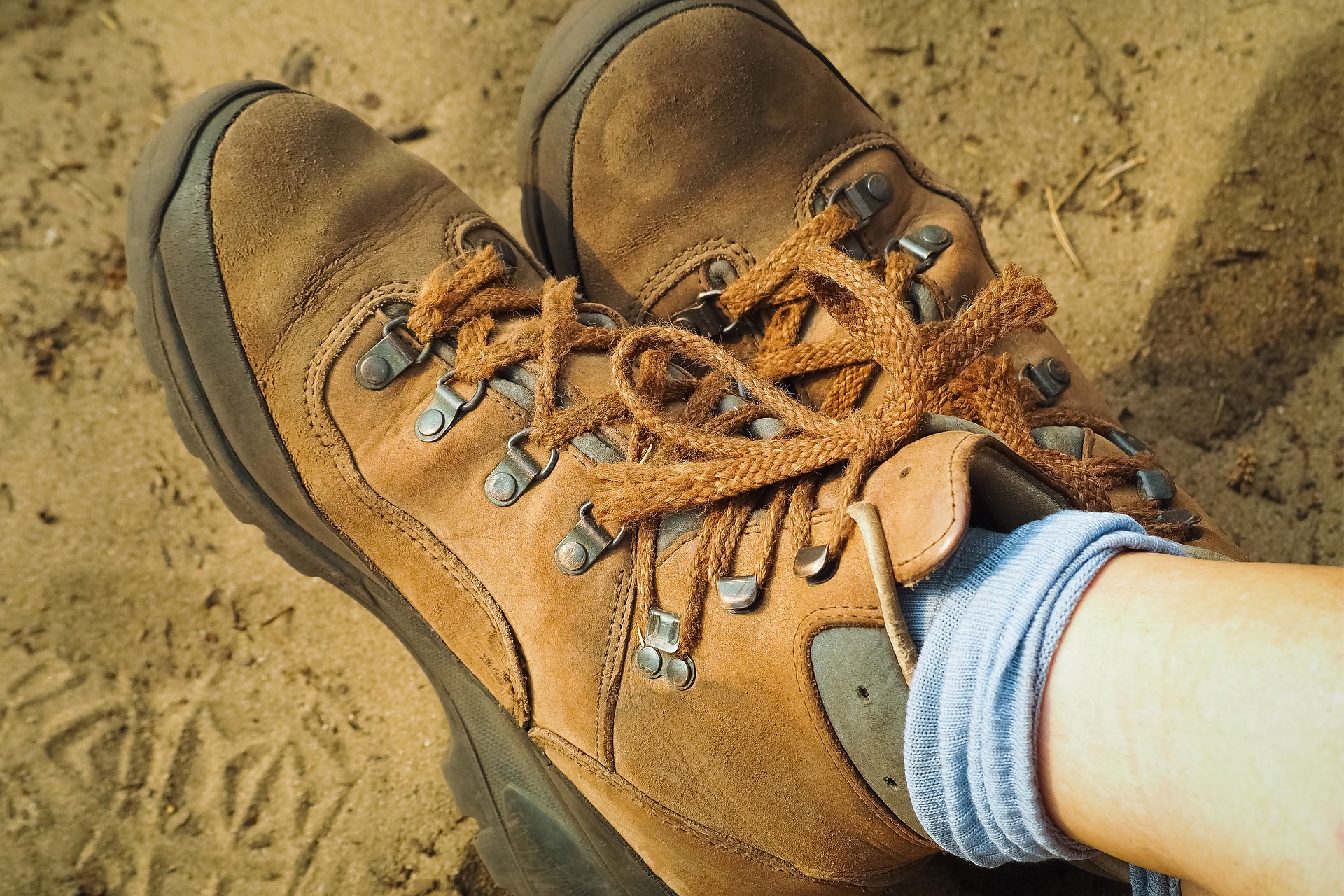
Finding the best hiking socks for your needs is an investment you’ll enjoy for years to come.
Unlike conventional socks made from cotton, true hiking socks are made from either wool, synthetic materials, or a combination of both, and keep your feet warm and protected from rough terrain and weather alike.
Hiking socks come in several different styles, lengths, and thicknesses, so finding the right one for you can be a bit of trial and error. But once you’ve found the perfect hiking sock, you’ll wonder how you ever went without.
In this guide, we will break down your options for materials, lengths, and thicknesses to consider, as well as how to make sure your sock is a good fit for your foot.
The Best Hiking Sock Materials
Wool
Chances are the sock you’ll ultimately wind up with is going to be mainly, if not 100 percent, made from wool.
And before you shudder at the thought of buying an itchy holiday sweater for your feet, just know that wool has come a long way in the last few decades.
Most hiking socks are now made from merino wool, which is both soft on the skin and can be made into thinner, lighter-weight textiles than you might expect.
Merino wool also retains the best properties of traditional wool in that it is incredibly long-lasting (some brands like DarnTough even offer lifetime warranties on their socks) and naturally antimicrobial (which means they don’t retain the unpleasant smells you’d expect after spending long hours in a hot hiking boot).
Synthetics
Synthetic fibers are a popular option for hiking socks and a variety of other hiking gear because they absorb little to no water, and will continue insulating even when wet.
Most synthetic hiking socks and other hiking gear are made from polyester and/or nylon, so they won’t have that “itchiness” factor that some will attribute to woolen garments.
You might be thinking, So are there any drawbacks to polyester?
In a word, yes.
Although many modern polyester socks and garments are given an antimicrobial treatment to help stop odor-causing bacteria from growing on the fabric, they still tend to grab and hold onto smells much faster than wool alternatives.
That’s something to consider when you’re planning on spending a week straight in the same 1-2 pairs of socks (or underwear) out on the trail.
And although many of the big-name manufacturers of outdoor gear like Patagonia and North Face have made notable efforts to reduce the environmental impacts of sourcing and producing their synthetic materials, synthetic fibers like polyester and nylon create “microplastic” pollution, which enters our oceans and ultimately many of the foods we eat.
A little research here will help you decide what best fits your needs, but any combination of these materials is going to be exponentially better than any cotton or cotton blend product on the market.
Why No Cotton On The List?
You may be wondering why a good pair of thick cotton socks isn’t mentioned anywhere in this guide.
There’s a good reason.
The materials recommended in this guide are used for hiking socks because they both wick moisture away from your skin, and are able to dissipate it back into the air.
Cotton is a serious no-no for any serious outdoors clothing because cotton fibers are hollow, and thus soak up and retain any moisture they come into contact with.
How serious can it be, you ask?
“Cotton Kills” is a phrase you’ll hear often among experienced outdoors enthusiasts, and it’s no exaggeration. Wearing cotton for any prolonged amount of outdoors activity can lead to hypothermia, even when the temperatures outside are above freezing.
The issue with cotton fibers is two-fold. First, as we stated above, the fibers rapidly absorb water, and once they’ve absorbed it, they hold onto it for a long time. Second, once cotton gets wet, it stops working to insulate your body by trapping warm air close to your skin.
Both wool and synthetic clothing will retain drastically less water, and what’s more, they will continue to provide warmth even when soaking wet.
Finding The Right Length For You

The optimal length of your hiking sock is going to depend largely on the kind of footwear it’s going into.
There are plenty of options on the market nowadays, ranging from “no-show” below the ankle cuts all the way up to “over-the-calf” mountaineering versions.
Comfort is the main focus here, but warmth can play a part too.
No-show socks may be fine if you decide to go with a lightweight trail runner option instead of a traditional hiking boot, but chances are you’ll be looking for either an ankle cut or crew length sock for two reasons.
First, the sock needs to be tall enough to prevent your boots from rubbing on your ankles and legs, causing unnecessary discomfort and blistering.
Even the lowest cut trail runners will brush up against the bottom of your ankle bone when hiking up and down hills, so ankle cut is likely going to be the lowest you want to go.
The second factor we like to take into account is compatibility with base layers.
If you’re eventually going to be hiking in colder conditions, it’s nice to be able to bring your hiking socks up over the bottom of your base layers or leggings to keep the cold out of any gaps between the two.
For these reasons, we typically recommend something between an ankle and a crew cut sock.
Anything higher than a crew cut sock is going to be overkill for most situations, but if you’ve got hiking over ice or deep snow in your near future, you may want to consider these as well.
Thickness

The thickness of your hiking sock is going to decide how much cushioning your feet will have from both your footwear and the terrain underneath.
Modern hiking socks can come with anything from zero cushioning, super-thin socks (typically used more for active sports like running and cycling in hot weather), all the way up to the super-thick socks best suited for traversing snow-covered mountains and other seriously cold scenarios.
Chances are, you’re going to find your ideal candidate somewhere between these two extremes.
We recommend checking out a variety of socks on offer, and also taking into consideration both the footwear you’ll be wearing and the conditions you’ll be hiking in.
Hikers with larger, chunkier leather boots often prefer thicker socks with more cushioning, while those using lighter options like hiking shoes or trail runners can get away with a medium to low thickness sock and still be comfortable.
In terms of weather, just keep in mind that although adding a thicker sock can mean adding more comfort and cushioning, the thicker you go the hotter your sock will run, so make sure to take the temperatures you’ll be hiking in into account when you’re packing your bag.
Medium-thickness socks nowadays often do a great job of providing ample cushioning along the footbed while also utilizing thinner materials over the top of your foot. This allows them to minimize bulkiness while increasing moisture-wicking performance, so we recommend starting somewhere in the middle and expanding your search from there.
Fit
Ok, so you’ve got your ideal hiking sock in mind, including the material, length, and amount of cushioning you’re going to be most comfortable with.
What’s the last thing to do before setting out on a long hike?
Make sure you’ve got the right fit.
Because one of the biggest reasons we wear special hiking socks rather than normal crew socks when we go hiking is to prevent blisters, the fit of your new sock is going to be crucial.
Most quality hiking socks will have a visible heel and toe section that are colored differently than the rest of the sock. As a general best practice, you want to make sure these sections line up with your actual heel and toe without any undue pressure or bunching up on your foot to ensure a good fit.
Snug but not overly tight is the goal, as we don’t want the sock moving around any more than necessary inside your boot, causing increased friction, and thus, increased blisters.
Pin it for later!
